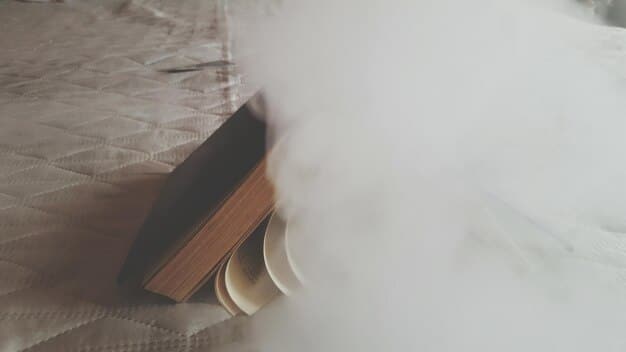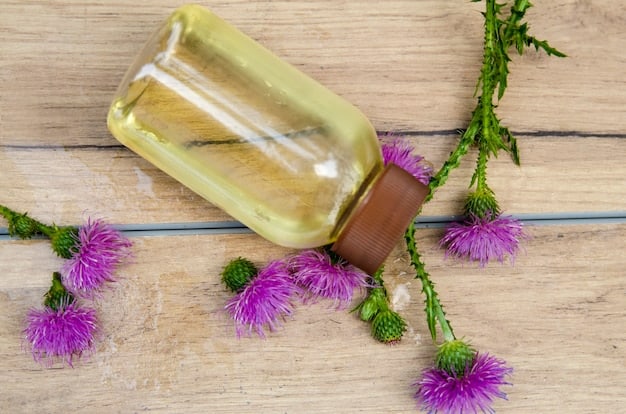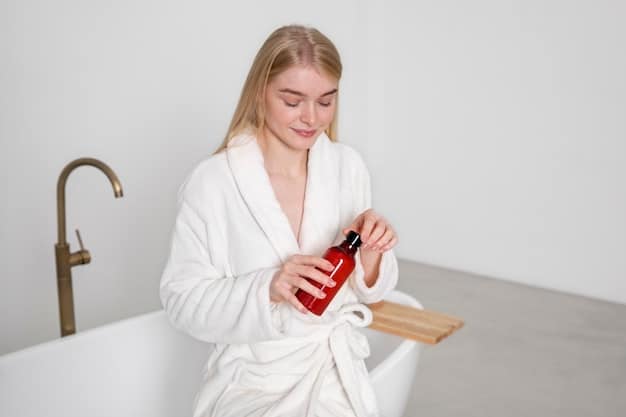Aromatherapy for Sleep & Stress: Reduce Both by 15% in 2 Weeks

Aromatherapy offers a natural way to improve sleep quality and reduce stress levels; using essential oils like lavender and chamomile in specific methods—such as diffusers, baths, and massage—can lead to a measurable reduction in stress and improved sleep within a two-week period.
Are you struggling with sleepless nights and constant stress? Discover how to use aromatherapy to improve your sleep and reduce stress by 15% in 2 weeks. This natural method leverages the power of essential oils to promote relaxation and better well-being.
Understanding Aromatherapy: A Beginner’s Guide
Aromatherapy is more than just a pleasant scent; it’s a holistic healing practice that uses natural plant extracts to promote health and well-being. Essential oils, derived from flowers, herbs, and trees, are the heart of aromatherapy. These oils contain potent compounds that can affect mood, reduce anxiety, and improve sleep.
What Are Essential Oils?
Essential oils are concentrated plant extracts that retain the natural smell and characteristics of their source. The extraction process, typically involving steam distillation or cold pressing, separates the oil from the plant material. This process creates a powerful essence that can be used in various ways.
How Does Aromatherapy Work?
The magic of aromatherapy lies in its unique ability to engage both the olfactory system and the limbic system. When you inhale essential oils, the scent molecules travel through your nasal passages to the olfactory receptors, which then send signals directly to the brain’s limbic system—the area responsible for emotions and memories. This interaction can trigger various physiological responses, such as relaxation, stress reduction, and improved mood. Furthermore, when applied topically, essential oils are absorbed into the bloodstream, offering systemic benefits.
- Inhalation: Diffusers, steam inhalation, and direct sniffing.
- Topical Application: Massage oils, lotions, and bath products.
- Ingestion: Primarily used under professional guidance.

The effectiveness of aromatherapy also depends on the quality of the essential oils used. Pure, therapeutic-grade oils are free from additives and synthetic fragrances, ensuring you receive the full benefits of the plants. Always look for reputable brands that provide detailed information about their sourcing and extraction processes.
In summary, aromatherapy is a natural and effective way to tap into the healing properties of plants. By understanding how essential oils work and choosing high-quality products, you can create a personalized aromatherapy routine to improve your sleep and reduce stress.
Top Essential Oils for Sleep and Stress Reduction
Selecting the right essential oils is crucial for achieving the desired effects of aromatherapy. Certain oils have been proven to be particularly effective in promoting relaxation, improving sleep quality, and reducing stress. Here are some of the best essential oils to consider.
Lavender Oil
Lavender is perhaps the most well-known essential oil for relaxation and sleep. Its calming scent has been shown to reduce anxiety, lower blood pressure, and promote restful sleep. Studies have indicated that lavender oil can increase slow-wave sleep, the stage associated with deep, restorative rest.
Chamomile Oil (Roman)
Roman chamomile is another excellent choice for promoting relaxation and reducing stress. Its sweet, apple-like aroma has a soothing effect on the mind and body, making it an ideal oil for creating a peaceful bedtime environment. Chamomile has also been used to alleviate symptoms of anxiety and depression.
Bergamot Oil
Bergamot, a citrus fruit, yields an essential oil that is both uplifting and calming. Its unique scent can help reduce feelings of stress and improve mood. Studies have shown that bergamot oil can lower cortisol levels, the hormone associated with stress. It’s often used in aromatherapy to combat anxiety and depression.
Other Beneficial Oils
- Sandalwood: Promotes relaxation and reduces anxiety.
- Ylang Ylang: Calms the nervous system and lowers blood pressure.
- Cedarwood: Grounding and promotes restful sleep.
Experimenting with different essential oils can help you discover which ones work best for you. Consider blending oils to create custom aromatherapy blends that target your specific needs and preferences. A blend of lavender and chamomile, for example, can be particularly effective for promoting sleep, while a combination of bergamot and sandalwood can help reduce stress and improve mood.

Ultimately, the best essential oils for sleep and stress reduction are those that resonate with you personally. Pay attention to how different scents make you feel and choose oils that evoke feelings of calm, comfort, and relaxation.
Creating Your Aromatherapy Routine: Step-by-Step
Once you’ve selected your essential oils, the next step is to incorporate them into your daily routine. There are several ways to use aromatherapy to improve sleep and reduce stress. Here is a simple step-by-step guide to help you get started.
Choose Your Method of Application
The method you choose will depend on your preferences and lifestyle. Some popular methods include:
- Diffusers: An essential oil diffuser disperses the oil into the air, creating a fragrant and therapeutic atmosphere.
- Topical Application: Applying diluted essential oils to the skin can provide localized relief and systemic benefits.
- Aromatherapy Baths: Adding essential oils to a warm bath can be a luxurious and relaxing way to unwind.
Set Up Your Environment
Creating a calming environment is essential for maximizing the benefits of aromatherapy. Dim the lights, turn off electronic devices, and ensure the room is quiet and comfortable. You might also consider playing soft, soothing music to enhance the relaxation experience.
Incorporate Aromatherapy Into Your Bedtime Routine
Aromatherapy can be a powerful tool for improving sleep quality. Here are a few ways to incorporate it into your bedtime routine:
- Diffuse essential oils: Place a diffuser with lavender or chamomile oil in your bedroom about 30 minutes before bedtime.
- Apply topically: Dilute a few drops of essential oil with a carrier oil (such as coconut or jojoba oil) and massage it into your temples, wrists, or the soles of your feet.
- Take an aromatherapy bath: Add 5-10 drops of essential oil to a warm bath and soak for 20-30 minutes.
By following these steps, you can create a personalized aromatherapy routine to improve your sleep and reduce stress. Remember consistency is key as you integrate aromatherapy into your daily life to achieve sustained results.
DIY Aromatherapy Blends for Sleep and Stress
Crafting your own aromatherapy blends can be a fun and rewarding way to personalize your aromatherapy experience. By combining different essential oils, you can create custom scents that target your specific needs. Here are a few DIY aromatherapy blends to try.
Sleep-Inducing Blend
This blend combines the calming properties of lavender and chamomile with the grounding scent of cedarwood to promote restful sleep:
- 3 drops lavender oil
- 2 drops Roman chamomile oil
- 1 drop cedarwood oil
Add this blend to a diffuser or dilute with a carrier oil for topical application.
Stress-Relieving Blend
This blend combines the uplifting scent of bergamot with the relaxing properties of frankincense and ylang-ylang to reduce stress and improve mood:
- 3 drops bergamot oil
- 2 drops frankincense oil
- 1 drop ylang-ylang oil
Use this blend in a diffuser, add it to a warm bath, or dilute with a carrier oil for topical application.
Anxiety-Reducing Blend
This blend combines the soothing properties of sandalwood and orange with the calming scent of clary sage to alleviate anxiety and promote relaxation:
- 2 drops sandalwood oil
- 2 drops sweet orange oil
- 2 drops clary sage oil
Diffuse this blend during times of stress or anxiety, or dilute with a carrier oil for topical application.
When creating your own aromatherapy blends, it is essential to use high-quality, pure essential oils and follow proper dilution guidelines. Always test a small amount of the blend on your skin before applying it more liberally to ensure you don’t have an allergic reaction. By experimenting with different oils and blends, you can discover the perfect combination to improve your sleep and reduce stress.
Measuring Your Progress: Tracking Stress and Sleep
To determine the effectiveness of your aromatherapy routine, it’s important to track your progress over time. Monitor your stress levels and sleep quality before you start aromatherapy, and continue tracking them throughout the two-week period. Here are a few ways to measure your progress.
Stress Scale
Use a simple stress scale (1-10) to rate your daily stress levels. Note your score each evening before bed. After two weeks of aromatherapy, compare your average stress level to your baseline.
Sleep Diary
A sleep diary can help you track various aspects of your sleep, such as:
- Time you go to bed
- Time you fall asleep
- Number of times you wake up during the night
- Time you wake up in the morning
- How rested you feel in the morning (rate on a scale of 1-5)
Wearable Technology
Consider using a fitness tracker or smartwatch to monitor your sleep patterns. These devices can provide data on sleep duration, sleep stages, and heart rate variability, which can be useful in assessing the impact of aromatherapy on your sleep quality.
After two weeks, analyze your data and compare it to your baseline measurements. Did your stress levels decrease? Did you fall asleep faster and sleep more soundly? Did you feel more rested in the morning? If you notice a significant improvement of around 15% in your sleep and stress levels, it’s a good indication that aromatherapy is working for you. If not, consider adjusting your aromatherapy routine by trying different essential oils, methods of application, or blends. Remember that aromatherapy affects everyone differently, so it may take some trial and error to find the perfect approach for your unique needs.
Safety Precautions and Tips for Aromatherapy
While aromatherapy is generally safe, it’s important to take certain precautions to avoid potential side effects. Like any health practice, aromatherapy requires responsible usage and awareness of potential risks.
Dilution
Essential oils are highly concentrated and should always be diluted before topical application. Use a carrier oil, such as coconut, jojoba, or almond oil, to dilute essential oils. A general guideline is to use a 1-3% dilution for adults, meaning 1-3 drops of essential oil per teaspoon of carrier oil. For children, pregnant women, and individuals with sensitive skin, a lower dilution is recommended.
Allergic Reactions
Before using a new essential oil, perform a patch test by applying a small, diluted amount to a small area of your skin. Wait 24 hours to see if you experience any adverse reactions, such as redness, itching, or irritation. If you do, discontinue use immediately.
Pregnancy and Breastfeeding
Some essential oils are not safe for use during pregnancy or breastfeeding. Consult with your healthcare provider or a certified aromatherapist before using essential oils during these times.
Storage
Store essential oils in a cool, dark place away from direct sunlight and heat. Keep the bottles tightly closed to prevent oxidation and evaporation. Properly stored essential oils can last for several years.
By following these safety precautions and tips, you can enjoy the benefits of aromatherapy without putting your health at risk. Remember, aromatherapy is a complementary therapy and should not replace conventional medical treatment. If you have any underlying health conditions or concerns, consult with your healthcare provider before starting an aromatherapy routine.
| Key Point | Brief Description |
|---|---|
| 🌿 Choosing Oils | Lavender, chamomile, and bergamot are great for sleep and stress. |
| 🛁 Using Methods | Diffusers, baths, and topical application are effective ways to use oils. |
| 🗓️ Tracking Progress | Monitor stress and sleep to see how aromatherapy helps. |
| ⚠️ Safety First | Always dilute oils and ensure no allergic reactions occur. |
FAQ
▼
Aromatherapy is the use of essential oils from plants to improve health and well-being. It works through inhalation and topical application, affecting the limbic system and bloodstream to promote relaxation.
▼
Lavender, Roman chamomile, and bergamot are excellent choices. Lavender is known for relaxation, chamomile for soothing effects, and bergamot for stress reduction and mood improvement.
▼
Use diffusers, apply diluted oils topically, or enjoy aromatherapy baths. Consistency is key. Diffuse oils before bed, or apply a diluted oil mix for relaxation.
▼
Always dilute oils to prevent skin irritation, do a patch test for allergies, and buy high-quality oils. Pregnant or breastfeeding women should consult a healthcare provider before use.
▼
Track your stress levels and sleep quality using stress scales, sleep diaries or wearable technology. Compare your results over a two-week period to monitor for positive changes.
Conclusion
Incorporating aromatherapy into your daily routine can be a simple and effective approach to achieving better sleep and reducing stress. By choosing the right essential oils, using them safely, and tracking your progress, you can experience a measurable improvement in your overall well-being. Give it a try and discover the transformative power of aromatherapy.





